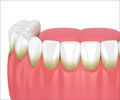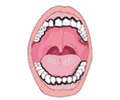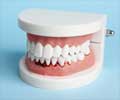Treatment of Periodontitis
The treatment of periodontitis could range from a non-invasive, non-surgical treatment such as scaling and prescription of antibiotic medications to complex, invasive surgeries.
The treatment of periodontitis depends upon the severity of the disease. The onus of treatment lies on preventing damage to the bones and ligaments by thoroughly cleaning the regions of infection. A periodontist or a dentist performs the treatment procedure. A daily routine for maintaining a good oral hygiene is essential for treatment success.
Non-surgical treatments: Early grade periodontitis is treated with medications and less invasive procedures that include:
- Scaling - Scaling is performed through instruments and ultrasonic devices to remove the tartar and bacteria from the surface of the teeth and underneath the gums.
- Root planing - Root planing will make the root surfaces smooth, which prevent further buildup of tartar.

- Antibiotics - Antimicrobial mouth-rinsewith chlorhexidine is most commonly used as the first-line therapy for gingivitis and gum infections. Oral or topical antibiotic gels or antibiotic microspheres containing doxycycline or minocycline are also prescribed to control bacterial growth and spread of infection.
Surgical treatments: Surgical options are recommended for advance level or rapidly progressing periodontitis, when the non-surgical treatment and antibiotics turn ineffective. The following dental surgical treatments are used in the treatment of advanced periodontitis:
- Flap surgery (pocket reduction surgery). Flap surgery involves removing a section of gum tissues to effectively clean and remove tartar and then stitching back the removed gum tissue in its place to allow stiffer binding. Since periodontitis frequently causes bone loss, the bone is reshaped before the gum tissue is sutured back in place.
- Soft tissue grafts. When you lose gum tissue to periodontal disease, your gumline recedes, making teeth appear longer than normal. This is usually done by removing a small amount of tissue from the roof of one’s own mouth (palate) or another donor source and is reattached to the affected site. This procedure can help reduce further gum recession, cover exposed roots and give your teeth a more cosmetically pleasing appearance.

- Bone grafting. When the bone and tissues surrounding the tooth root are destroyed to periodontitis, bone-grafting procedure is performed. The bone-graft is composed of small fragments of bone-tissues that may be of your own, synthetic or borrowed tissue. The bone-graft or bone-transplant prevents tooth loss, and also helps re-growth of natural bone. Guided Tissue Regeneration Technique is used for Bone- grafting.
- Guided tissue regeneration: The procedure is used in advanced periodontitis. It allows the re-growth of the bone damaged by bacterial infection. In this procedure, the dentist put a special biocompatible fabric between the bone and the tooth to prevent further infection and allow effective natural healing.
- Enamel matrix derivative application. The technique involves deep application of specialized gels embedded with the proteins necessary for bone growth on to a diseased tooth root to stimulate natural healing by bone re-growth.
The success of any surgical treatment depend on several factors such as the depth of the disease, patients’ lifestyle and oral hygiene, other risk factors such as smoking or genetic susceptibility and others.


















